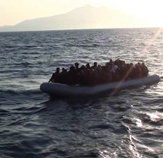 31 May 2013 - Each year, around 500,000 migrants - mainly from Myanmar, but also from Cambodia and Lao PDR - are smuggled into Thailand, while China and Viet Nam are source countries for migrants smuggled to the United States (USA) and the European Union (EU), according to the recently released UNODC report on
Transnational Organized Crime in East Asia and the Pacific - A Threat Assessment.
31 May 2013 - Each year, around 500,000 migrants - mainly from Myanmar, but also from Cambodia and Lao PDR - are smuggled into Thailand, while China and Viet Nam are source countries for migrants smuggled to the United States (USA) and the European Union (EU), according to the recently released UNODC report on
Transnational Organized Crime in East Asia and the Pacific - A Threat Assessment.
"Migrant smuggling is a high-profit, low-risk big business. It is also a deadly business," says Mr. Sebastian Baumeister, UNODC Expert and Analyst on Migrant Smuggling based in Bangkok at the Regional Office for Southeast Asia and the Pacific. "Migrant smuggling puts migrants at risk of abuse, exploitation and human trafficking - and at the risk of losing their lives."
The report is the first comprehensive study of transnational organized crime threats in East Asia and the Pacific. It details the criminal flows involved and provides estimates of annual revenues generated for criminal groups by various activities, including those related to human trafficking and the smuggling of migrants.
The Report dedicates three chapters to migrant smuggling: Within the Greater Mekong Sub-Region; From East and Southeast Asia to Europe and the United Stated; and From Southeast Asia to Australia and Canada.
Viet Nam and China are important countries of origin for migrant smuggling out of Southeast and East Asia, says the report, which concludes that the overwhelming majority of irregular migrants resorts to the assistance of highly professional smuggling networks. Mainly driven by economic ambition, Vietnamese and Chinese irregular migrants pay fees that can exceed 50,000 USD. With more than 70,000 migrants smuggled to Europe and the USA each year, this illustrates why long-distance smuggling is a profitable crime for organized criminal networks.
Migrants to Australia, on the other hand, are mainly driven by insecurity and the prospects of getting granted asylum, the report says. Smugglers to Australia specialize in handling people who have high chances of being granted asylum, in particular migrants from Afghanistan, Iran, Iraq, and Sri Lanka. Between 2009 and 2012, an annual average of 6,000 smuggled asylum seekers reached Australia by boat. Yet, in the year 2012 alone, more the 17,000 migrants were smuggled by sea to Australia, paying fees from 7,000 to 18,000 USD per person.
With Southeast Asia, economic disparities drive irregular migration. Fees for smuggling services are comparatively low. Mr. Baumeister notes that while countries have established formal labour migration systems, some of these tend to be complicated, time-consuming and expensive. As a result, migrants see smuggling as a cheaper alternative.
"Migrant smugglers easily adapt to changes in government policy. They offer a wide range of services, ranging from basic to highly sophisticated, and from cheap to expensive," says Mr. Baumeister. "The challenge is to get the organisers, but most of them are in the countries of origin and transit, and it's very difficult to get hold of them. Better monitoring and enforcing labour standards would help protect irregular migrants in the destination countries and reduce the demand for migrant smuggling."
Therefore, the reports calls for complementing border controls by fostering intelligence-led approaches to investigation. The criminals - in particular the organizers - face little risks of detection. "The challenge is to bring the perpetrators to justice and to seize their profits to make migrant smuggling unprofitable," says Mr. Baumeister.
Acknowledging that border controls and law enforcement alone cannot solve the problem of migrant smuggling, the Report emphasizes that such efforts have to be embedded into wider migration and development policies and calls for fostering regional and inter-regional cooperation at both the levels of policies and law enforcement operations. Bilateral responses to smuggling, the report notes, may only result in a displacement of routes - and transfer it elsewhere.
"No country is immune to the threat posed by the smuggling of migrants and other transnational organized crimes," says Mr. Jeremy Douglas, Regional Representative, UNODC Regional Office for Southeast Asia and the Pacific. "These illicit activities are a threat to security, good governance, human rights and sustainable development - in this region and around the world. We need governments' help to gather data, share it, and create an effective response."
Transnational Organized Crime in East Asia and the Pacific - A Threat Assessment Report